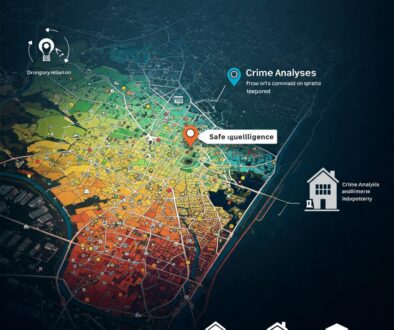Commercial vs. Residential: Using GeoIntelligence to Choose Your Investment Type
The commercial versus residential investment decision has traditionally been approached as a broad strategic choice based on investor preferences, capital constraints, and general market conditions. Investors typically select their focus based on personal experience, perceived risk tolerance, or conventional wisdom about each category’s characteristics.
Yet this generalized approach fails to recognize that the optimal investment type varies dramatically by specific location, timing, and market conditions. A location that’s perfect for residential might be suboptimal for commercial, while another site might offer exceptional commercial potential despite mediocre residential prospects.
In 2025, AI-powered geospatial intelligence platforms like Locas.dev are transforming this decision-making process, moving beyond broad asset class generalizations to provide location-specific, data-driven guidance on whether commercial or residential investment offers superior potential for particular properties and market conditions.
The Traditional Commercial vs. Residential Decision
Conventional Approach
The traditional decision between commercial and residential investment typically involves considering:
- Investor experience and comfort level with each asset class
- Capital requirements and financing availability
- General market cycles for each sector
- Management intensity preferences
- Basic return expectations and risk tolerance
Investors then apply these general preferences to specific opportunities, often focusing primarily on the property itself rather than its location’s particular suitability for one investment type versus another.
Limitations of the Traditional Approach
This conventional approach suffers from several significant weaknesses:
- Overgeneralization of asset class characteristics
- Insufficient location-specific analysis
- Limited understanding of timing factors
- Inadequate micro-market differentiation
- Minimal cross-category comparative analysis
“Investors often decide they’re a ‘residential investor’ or ‘commercial investor’ as a general strategy, then look for properties within that category,” explains real estate economist Dr. James Chen. “But this approach fundamentally misses that specific locations may strongly favor one investment type over another regardless of your general preference.”
How AI Transforms the Commercial vs. Residential Decision
Modern geospatial intelligence platforms transform this decision through:
1. Location-Specific Investment Type Optimization
Traditional Approach: General assessment of area as “good for residential” or “a strong commercial district” based on simple observations and basic demographic data.
AI-Enhanced Approach: Sophisticated location optimization includes:
- Use-specific potential scoring for each investment category
- Comparative return potential analysis between commercial and residential
- Investment type alignment with location characteristics
- Timing-sensitive opportunity assessment for each category
- Micro-location suitability mapping at sub-neighborhood scale
Real-World Impact: “We were evaluating a property that conventional wisdom suggested was ideal for residential development given strong housing demand in the area,” notes Sarah Johnson of Meridian Development. “However, our AI analysis revealed the specific site had exceptional commercial potential due to a unique combination of visibility, traffic patterns, and proximity to complementary businesses—factors not obvious in traditional analysis. By developing a commercial project instead of residential, we achieved a 31% higher return on investment than comparable residential developments in the same district.”
2. Demand-Supply Imbalance Identification
Traditional Approach: Basic understanding of general market conditions for each sector, with limited ability to identify specific imbalances in particular locations.
AI-Enhanced Approach: Detailed imbalance intelligence includes:
- Category-specific demand-supply gap analysis
- Future demand projection modeling by investment type
- Supply pipeline assessment for different categories
- Demographic alignment scoring with different uses
- Price elasticity measurement for various investment types
Real-World Impact: A developer was considering two potential uses for a property in a mixed-use district. While traditional analysis showed generally strong conditions for both commercial and residential, AI-powered demand-supply analysis identified a specific and growing imbalance in Class B medical office space, with demand significantly outpacing existing and planned supply. This intelligence led them to develop a medical office building that achieved 23% higher rent premiums than originally projected and 100% lease-up within four months of completion.
3. Timing-Sensitive Category Advantage Analysis
Traditional Approach: General awareness of market cycles for different sectors, but limited ability to identify precise timing advantages at specific locations.
AI-Enhanced Approach: Sophisticated cyclical analysis includes:
- Cycle position identification for different investment types
- Recovery sequence mapping across commercial and residential
- Early indicator detection for category-specific upturns
- Regulatory change impact assessment on different uses
- Capital flow timing analysis across investment categories
Real-World Impact: “Our AI platform identified a specific cycle timing advantage for multifamily over retail in what had traditionally been a strong commercial corridor,” explains Michael Martinez of Capital Partners. “The analysis showed that the area was in the early stage of a residential upswing while commercial was near its cyclical peak. By pivoting to residential on a site originally slated for retail, we positioned our investment to ride the upward residential trajectory while avoiding the commercial flattening that occurred over the following 24 months.”
4. Risk-Adjusted Return Comparison
Traditional Approach: Basic yield comparison between categories with limited ability to properly quantify and compare risk factors specific to location and timing.
AI-Enhanced Approach: Comprehensive risk-return analysis includes:
- Location-specific risk factor identification for each type
- Volatility projection modeling across investment categories
- Downside scenario testing for different use types
- Regulatory risk exposure comparison between options
- Exit strategy robustness assessment for each category
Real-World Impact: An investor was comparing two potential investments—a retail center and a multifamily complex—in the same submarket. While the retail property showed higher projected returns in base-case scenarios, AI-powered risk analysis identified significantly higher downside risk due to e-commerce vulnerability in the specific retail categories present. The risk-adjusted return analysis showed the apparently lower-yielding multifamily investment actually offered superior risk-adjusted returns, a prediction that proved accurate when the retail center experienced higher-than-market vacancy during a subsequent economic slowdown.
5. Conversion Opportunity Assessment
Traditional Approach: Limited ability to identify properties with strong conversion potential between commercial and residential uses or to accurately quantify the value creation opportunity.
AI-Enhanced Approach: Detailed conversion intelligence includes:
- Structure conversion suitability assessment
- Regulatory feasibility analysis for use changes
- Post-conversion value projection modeling
- Conversion cost estimation based on building characteristics
- Market receptivity forecasting for converted properties
Real-World Impact: “The AI platform identified a commercial property with exceptional residential conversion potential that wasn’t apparent in traditional analysis,” notes Jennifer Wu of Urban Rehabilitation Partners. “The system evaluated the building’s structural characteristics, floor plate configuration, window placement, and mechanical systems, then calculated both conversion costs and potential post-conversion value. This comprehensive assessment revealed a value creation opportunity 45% higher than continuing the commercial use, leading to a highly successful apartment conversion that outperformed initial projections.”
Case Study: The Crossroads District Decision
When Horizon Investments was evaluating a property in a transitioning urban district, they employed both traditional analysis and AI-powered comparative assessment:
Traditional Assessment:
- Area showed healthy demand for both office and residential
- Property was in a mixed-use zone allowing either category
- Comparable developments included both successful office and residential projects
- Site had good attributes for either use type
- General market reports showed positive outlook for both sectors
AI-Enhanced Intelligence:
- Location-specific analysis revealed 28% higher potential returns for residential
- Demand-supply imbalance was significantly greater in residential category
- Residential market was earlier in its cycle with more runway for growth
- Risk factors for office were 42% higher due to specific tenant profile in the area
- Timing analysis showed residential entering a growth acceleration phase
Based on this comprehensive intelligence, Horizon:
- Pivoted from their original office concept to residential development
- Refined their residential product to specifically target the highest-demand segments identified
- Designed flex spaces that could adapt to changing demands
- Phased their development to align with projected residential demand growth
- Incorporated limited commercial components in strategic locations within the project
The result was a development that outperformed comparable office projects in the district by 37% in overall returns while experiencing significantly lower lease-up risk and volatility.
Key Factors in the Commercial vs. Residential Decision
Modern geospatial intelligence platforms analyze several critical factors to determine optimal investment type:
1. Location-Specific Demand Characteristics
- Commercial demand drivers like daytime population, business density, and traffic patterns
- Residential demand factors including employment accessibility, amenities, and school quality
- Competitive supply profile for each category in the micro-location
- Category-specific demographic alignment with local population
- Demand growth trajectories for different use types
2. Physical and Regulatory Considerations
- Site characteristics favoring particular use types (visibility, access, configuration)
- Building attributes suited to specific categories (floor plate, ceiling height, load capacity)
- Zoning and regulatory factors affecting different investment types
- Parking and transportation considerations for various uses
- Environmental factors with differential impact on commercial vs. residential
3. Economic and Market Timing Factors
- Cycle position for different investment categories
- Rent and price trend divergence between commercial and residential
- Absorption rate variations across categories
- Capital market conditions for different investment types
- Construction cost implications for various development approaches
4. Risk Profile Differentiation
- Tenant default risk variation between categories
- Lease term and turnover differences
- Operational complexity comparison
- Exit liquidity variations across investment types
- Regulatory risk exposure differences between categories
5. Future Adaptability Potential
- Conversion flexibility between different uses
- Expansion capability for various categories
- Repositioning potential within investment types
- Technological disruption vulnerability by category
- Mixed-use integration opportunities
Implementation Strategies for Investment Type Selection
To leverage AI-powered comparative analysis in your investment approach:
1. Begin with Location-Specific Analysis
Rather than starting with a predetermined investment category preference:
- Evaluate locations based on their specific potential for different use types
- Identify areas with exceptional opportunity in particular categories
- Look for locations with significant advantages for one type over another
- Match site characteristics to optimal investment categories
- Consider conversion potential for existing properties
2. Incorporate Cyclical Timing
Different investment types often follow different cyclical patterns:
- Identify where each category sits in its specific market cycle
- Target investments in categories with more favorable cycle positioning
- Consider counter-cyclical opportunities where appropriate
- Evaluate early indicators of cycle shifts for different use types
- Time exits based on category-specific cycle projections
3. Develop Use-Flexible Approaches
Create investment strategies that can adapt to changing category advantages:
- Consider designs with conversion potential between uses
- Incorporate flexible spaces adaptable to different functions
- Phase developments to respond to evolving category strength
- Create optionality in entitlements for different use types
- Structure partnerships and financing to accommodate changing use strategies
4. Match Investment Categories to Your Capabilities
Align category selection with your operational strengths:
- Consider management intensity differences between categories
- Evaluate your experience and expertise across investment types
- Assess capital requirements for different categories
- Analyze your team’s capability for various use types
- Consider strategic partnerships to expand category capabilities
5. Optimize Mixed-Use Combinations
In appropriate locations, combine categories strategically:
- Use AI analysis to identify optimal use combinations for specific sites
- Determine ideal proportions between different categories
- Strategically position different uses within a project
- Create synergistic relationships between complementary uses
- Phase mixed-use developments to match category-specific timing advantages
The Future of Investment Type Selection
As AI and geospatial intelligence continue to evolve, several emerging capabilities promise even more sophisticated investment category analysis:
Dynamic Use Optimization
Future systems will continuously monitor changing market conditions, automatically identifying optimal moments to shift between investment categories or to convert properties from one use to another.
Hybrid Category Identification
Advanced platforms will recognize emerging hybrid use categories and recommend innovative combinations that maximize returns while minimizing traditional category-specific risks.
Category Disruption Forecasting
AI will increasingly predict how technological and social changes might disrupt traditional investment categories, identifying both risks to conventional approaches and opportunities for innovative use types.
Multi-Scenario Use Modeling
Future intelligence will model multiple potential use scenarios simultaneously, allowing investors to create optionality-based strategies that can adapt to evolving market conditions.
Personalized Category Recommendation
Platforms will increasingly match investment category recommendations to your specific expertise, resources, and objectives, prioritizing opportunities that align with your unique situation.
Conclusion: From Predefined Categories to Optimized Opportunity
The commercial versus residential decision is increasingly less about general investor preference and more about location-specific, timing-sensitive optimization. The evolution from broad asset class generalizations to precise, data-driven category selection represents a transformative opportunity for investors to:
- Identify locations with exceptional category-specific potential
- Time investments to align with category-specific cycles
- Recognize conversion opportunities between investment types
- Optimize mixed-use combinations for specific properties
- Align investment categories with evolving market conditions
In a market where optimal use can dramatically impact returns, the competitive advantage increasingly belongs to investors who can transcend predetermined category preferences to identify the highest potential investment type for each specific opportunity.
Ready to optimize your commercial versus residential investment decisions? Try Locas.dev today and experience the power of AI-driven investment category analysis.
This article reflects the current state of AI technology in commercial versus residential investment analysis. For the latest updates and features, visit Locas.dev.
Keywords: commercial vs residential investment, real estate investment comparison, property type analysis, commercial or residential property, investment property types, AI real estate analysis, comparing real estate investments



